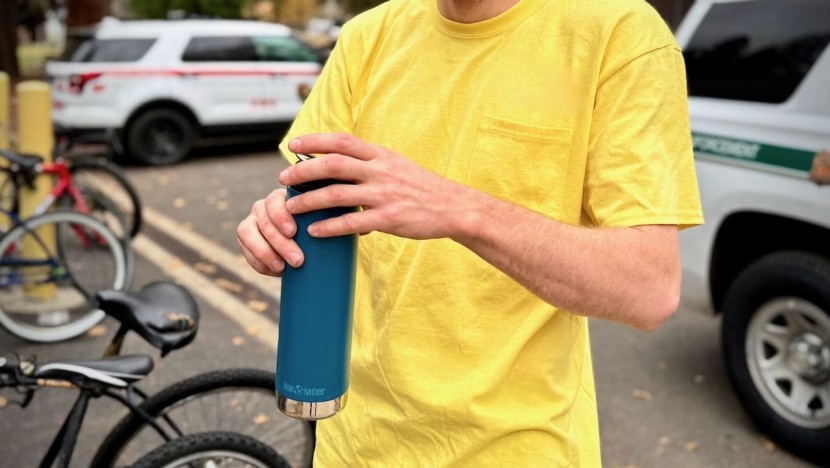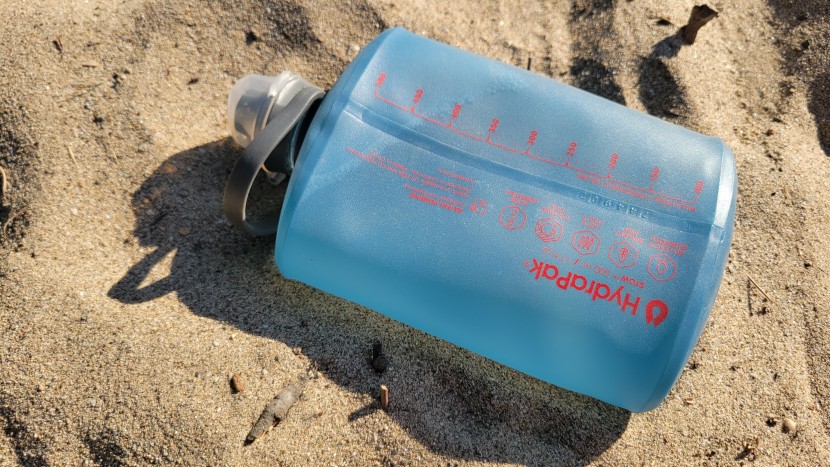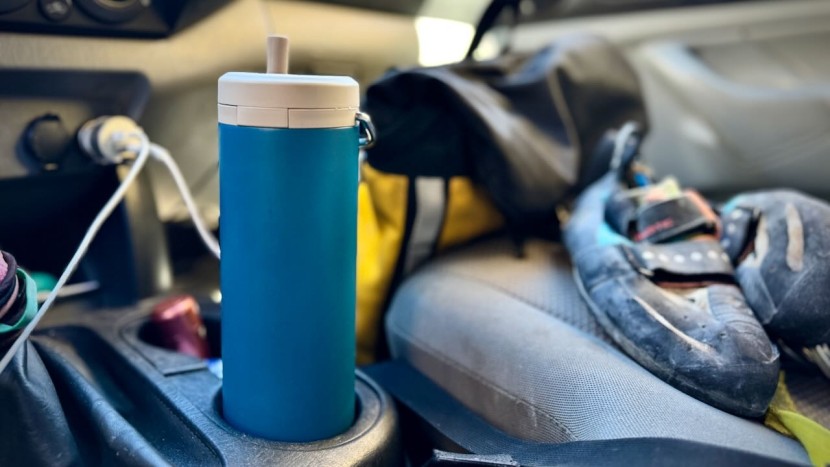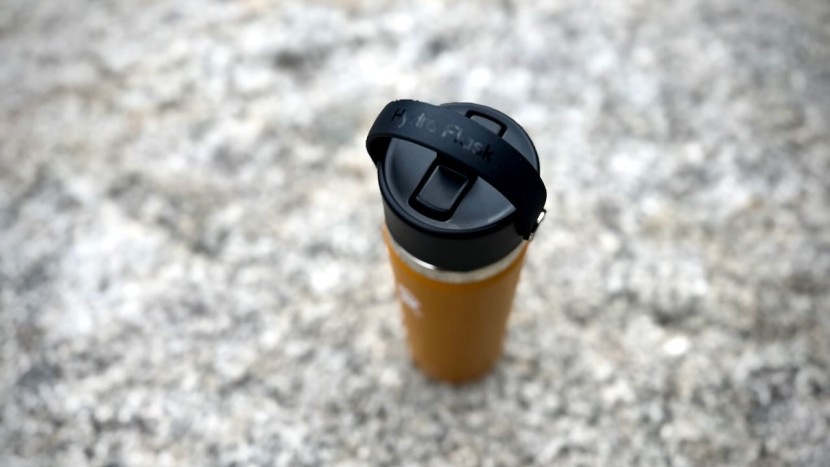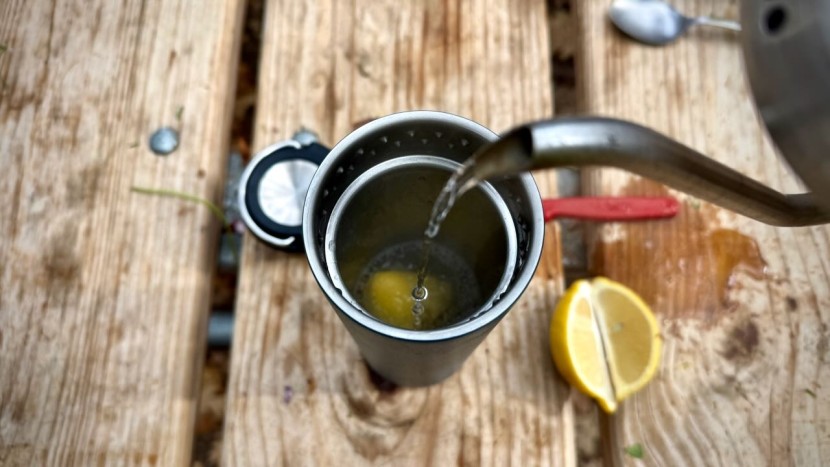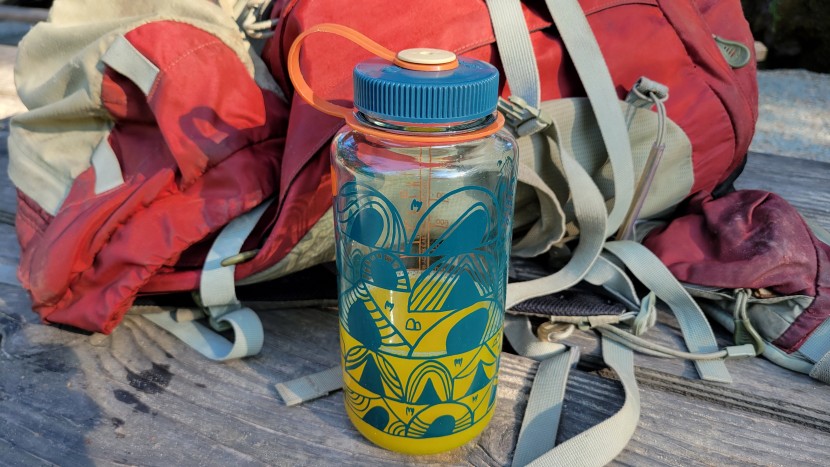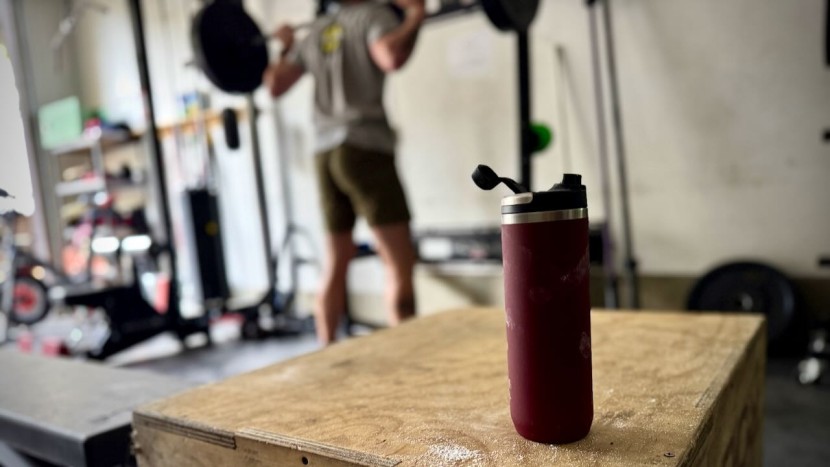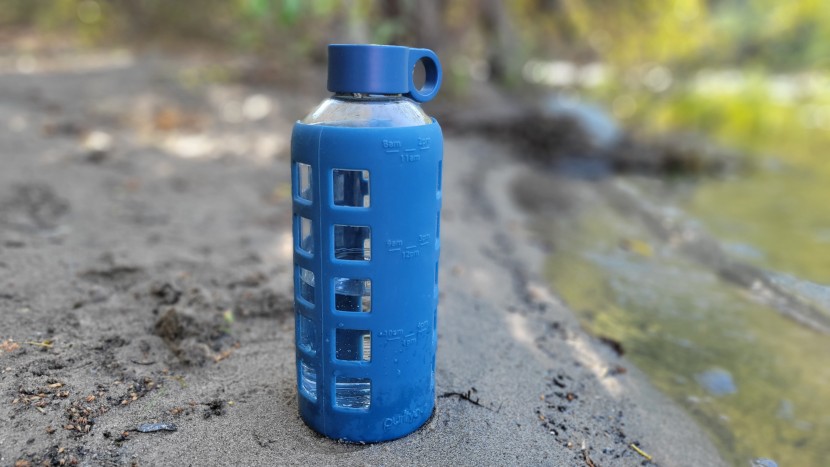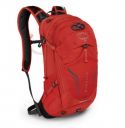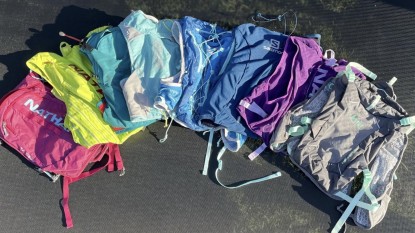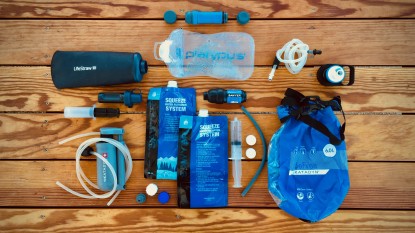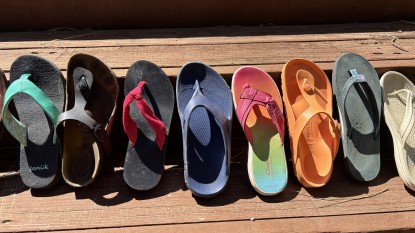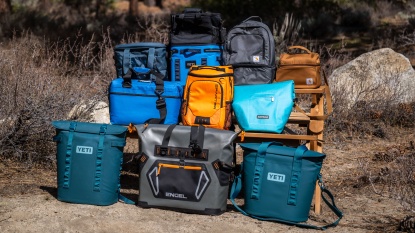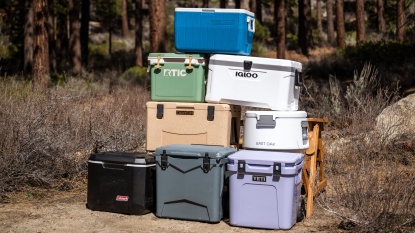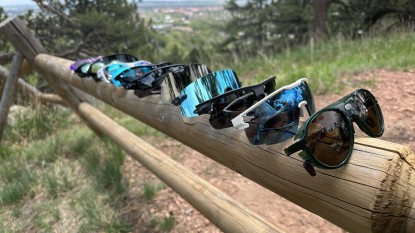Among the selection of water bottles in our review, we saw a lot of variation. We broke down our selection into four main categories: glass, collapsible, plastic, and stainless steel. Within these classifications, we found bottles designed for specific uses — bottles for one-handed drinking, integrated filter bottles, leak-proof bottles… the list goes on. When shopping for a water bottle, we first recommend you decide what kind of functionality you're looking for—and maybe which type of material—before you begin looking at specific options. Our testing metrics can help suss out which models excel in which areas. A bottle that's perfect for daily urban use might not be the right choice for a backpacking trip, as the needs differ. Furthermore, if you're trying to avoid plastic, look for stainless steel or glass options. These are just some examples, and we'll explain more tips on how to shop for water bottles in this article.
Some of these technological developments were impressive, while others seemed to just add complexity to the simple task of hydrating with water. In the following article, we outline the merits of the array of materials and features found in water bottle design. Hopefully, it will help you find the right bottle to match your lifestyle and needs.
Why Buy a Reusable Water Bottle?
If you don't already think a reusable bottle is a good idea, allow us to convince you with three simple points:
- It's better for the environment. Producing one bottle takes fewer resources and creates less pollution than the production of bottled water. Each refill saves a disposable plastic bottle from being made.
- A reusable bottle costs less over a relatively short amount of time. If you are buying bottled water each time you could be refilling a reusable bottle with tap water, you're throwing money away.
- Drinking from a reusable bottle is just as healthy as bottled water. With tap water being tested by local, state, and federal agencies, there is no reason to believe that it is less safe or clean than bottled water.
Things to Consider Before Buying
Before you hit the market, we recommend asking yourself a few questions first:
How Will I Use My Water Bottle?
Knowing how you plan to use your bottle will quickly narrow your field of choice. Is this bottle going to accompany you on rugged backpacking trips where you are counting the ounces of each item of gear? Or is it going to accompany you to yoga class, ready to grab a quick sip in between poses? Some bottles, like BPA-free plastic and stainless-steel options, are well suited for a wide variety of environments and activities.
Collapsible vs. Rigid
Collapsible bottles are in their prime when space is limited and weight is crucial. Unlike rigid bottles, they don't take up much space when they're empty. Just roll them up and pack them away. For this reason, they make great backup reservoirs on multi-day hikes. Not only handy in the backcountry, but collapsible bottles are also useful when traveling. These bottles are the most awkward to use and generally present low durability.
That said, there are many distinct advantages to having a rigid bottle. We found them generally easier to drink from, as they don't flop around. In a pinch, they can double as a blunt instrument, rolling pins, hammers, or improvised waterproof canisters. Rigid bottles typically insulate better than collapsible bottles, as well.
Lids, Caps, and Straws, Oh My!
The most basic purpose of a water bottle is to transport liquids so you can stay hydrated. All the bottles transport water, but some are easier to drink from than others. “Ease of Use” is a key consideration because it includes not only drinking from the bottle but carrying it and using the lid as well. Most of this depends on the lid type: is it a wide-mouth bottle? A flip-cap? A bottle with a narrow mouth? We also found that the standard screw cap isn't the most convenient for those of us seeking a bottle to keep us hydrated at work and on the move. New cap designs give you some options to assist you in staying hydrated throughout the day. When drinking straight from the bottle's body, narrow mouths are easier to use, while wide mouths are handier in the backcountry. Bottles with a screw cap, straw lid, flip top, and spouts were all present in our reviews. We also had a mix of wide and narrow mouths. We broke these up into two groups for further details.
Quick Access vs. Screw Cap
Most bottle brands offer a few drinking cap options and for everyday use, we prefer quick access caps. The quick access options available range from straws to button-operated flip caps. We found two advantages to these quick access cap types. First, they allow you quick, one-handed access to your liquids. Second, they actually affected how often we drank from our bottles. Perhaps it's because they are more convenient, or perhaps it's because they're just more fun, but we found that we drank more from a flip cap or straw-style bottle.
A disadvantage of using a quick access cap is that anytime you add parts, you add potential points of failure. Additionally, caps that have exposed drinking surfaces tend to get filthy. This may not be as much of a concern in the backcountry (just a bit of trail pepper), but if you plan on using your bottle daily, expect to be sanitizing it often.
The alternative is a simple screw-on, screw-off cap. We favor these in the great outdoors because they have a smaller chance of failing when away from a water source. They are easier to clean and to keep clean than most quick access caps. We also consider these caps very unlikely to open themselves inside our packs and leak liquids on our gear.
Narrow vs. Wide Mouth
In general, narrow-mouth bottles tend to be easier to drink from. They are less likely to splash down your chest, and you can usually continue moving while drinking, too. With some exceptions, the narrower mouths still allowed room for ice cubes and did not make filling the bottle much of a hassle.
Wide mouth bottles are easier to clean and fill, which we find to be crucial. The biggest advantage of wide-mouth bottles is their compatibility with many water filters. Most wide-mouth bottles produced today are also water filter compatible. This makes them more versatile and a good choice for gathering water from streams in the backcountry.
Hot and Cold - Best of Both Worlds?
If you want to switch from hot to cold beverages, or even just hot beverages, an insulated bottle is for you. The insulated bottles in our review kept hot liquids hot for 6-7 hours, and cold liquids cold for over 24 hours. They are what you need for transporting hot drinks to the office and in the outdoors in cold weather. Additionally, they shouldn't sweat when filled with cold drinks, making them great for cold juice, smoothies, and ice water anywhere you go. Keep in mind that insulated bottles are often more expensive, heavier, and bulkier, so factor that in when considering your next purchase.
Multiple Bottles?
We find that most bottle options are inexpensive enough to allow you the freedom of purchasing a few bottles, each with a specific purpose in mind. For example, you might want to purchase a glass or metal bottle for everyday use, yet have a plastic bottle reserved for specific outdoor rec activities. Or maybe you want an insulated bottle for your daily hot beverage and a non-insulated bottle for your athletic pursuits.
Types of Bottle Materials
Now that you've spent some thinking about what you need from a water bottle, let's dive into the different types of bottle materials. The three most common bottle materials are plastic, metal, and glass, with some variation within each classification. Each has its own list of pros and cons, as well as its best applications.
Plastic
Using plastic for water bottles gives manufacturers quite a bit of versatility. Plastic bottles can be rigid or collapsible, clear or colorful. They can be formed into a great variety of shapes. One of its greatest advantages, you can argue, is that plastic is cheap to make. Although plastic bottles can withstand some knocks, they are not 100% durable. Realizing that there are many different kinds of plastics available for a company to use for their bottles, we outlined some general pros and cons below - there are exceptions to these rules, but generally, this is what we found.
Pros- Lightweight
- More durable than glass
- Often less expensive
- Huge variety in design
- Translucent for better water management
- Able to freeze water inside
Cons
- Potential health concerns
- Less durable than metal
- Uses non-renewable resources to produce
We like using plastic bottles for extended backpacking purposes the best, especially in cold weather. The collapsible models make great backup water reservoirs that pack nicely, and the rigid bottles are insulated enough to avoid freezing inside our bags. On cold nights, nothing beats throwing a rigid plastic bottle filled with hot water into your sleeping bag for extra warmth. Additionally, traveling through airports with a collapsible bottle is slick and easy.
BPA and Estrogenic Activity
BPA (Bisphenol A) is a plastic-hardening chemical that has been abandoned in the water bottle industry in response to scientific research indicating its health risks. Over time, common stresses like hot liquids and exposure to UV light cause the bottle to break down, causing the chemicals used in the plastic to leach into the contents (typically water) of the bottle through direct contact.
The primary concern with BPA is that this chemical has been shown to be an endocrine disrupter in animal tests (See this scholarly article or this one.) This means that once inside the body, it can mimic the natural female sex hormone by attaching to estrogen-recognizing receptors, stimulating what is commonly referred to as estrogenic activity (EA). This would create a false presence of estrogen within the body. There is a concern that in humans, this can lead to a host of potentially negative consequences in fetal and child development, as well as the reproductive system. More information on BPAs from the National Institute of Health can be found here.
Today, plastic manufacturers use alternative plastic-hardeners to avoid using BPA and proclaim that fact loudly. Every bottle in this review came with a large sticker or tag indicating that it is BPA-free. However, the potential problem of other chemicals leaching into the contents of your bottle is not fully resolved.
What about other chemicals?
Although most water bottle manufacturers no longer use BPA, the problem is that BPA is only one of hundreds (or even thousands) of chemicals used to produce plastics. Other chemicals, including plastic softeners like phthalates, have also been called out as endocrine disrupters that lead to unnatural estrogenic activity. Six phthalates are currently banned by the FDA in the US, and even more in Europe. Unfortunately, there is very little research into the health risks of these and other chemicals, including those now used in place of BPA. Consider this quote from an article in Environmental Health Perspectives (a monthly peer-reviewed journal published with support from three federal U.S. health agencies):
That said, much of the scientific research surrounding EA and its effects is murky, controversial, and entangled with lawsuits.
What's being done about it?
The safety of consuming water from plastic bottles remains very controversial. The plastic industry claims that their plastics are completely safe and do not pose any health risks. According to their own research, only trace amounts of chemicals are ever leached, and these small amounts are quickly removed from the bloodstream through normal bodily processes. However, we feel that more independent research and scientific studies are necessary in order to come to this conclusion. In essence, a lack of scientific evidence does not equal proof that these chemicals are safe for humans. As pressure from the consumer market mounts, it is likely that more studies will be conducted concerning this matter.
I need something unbreakable, what do I do?
So, we're left with a complicated situation. The label BPA-free does not appear to mean that the product is free of estrogenic activity (EA), which seems to have been the very issue originally raised with regard to BPA itself. Yet, the science is murky as to what effect, if any, EA has on humans (maybe it just passes through your body harmlessly, or maybe not). So, what should you do if you want to protect yourself from potentially harmful compounds?
We think the conservative approach is to go with glass or stainless steel. Products made of glass and stainless steel are quite competitive, and in many outdoor activities, the added cost, weight, and breakage risk (in the case of glass) is just not a big deal. The potential health benefits will justify a bit more weight and cost for many consumers.
That said, those who choose the weight, durability, and other noted advantages of modern plastic water bottles, can know that we've looked carefully at this issue, and we found no scientific study that definitively proves a serious health risk.
Nonetheless, if you do use a plastic water bottle, we recommend these practices:- Do not heat up your bottle in the microwave.
- Do not use your plastic bottle for the consumption of hot liquids.
- Hand wash your plastic bottles, as opposed to tossing them in the dishwasher.
- Avoid UV exposure, such as leaving your bottle laying in the sun.
- Toss your bottle if the inside becomes heavily scratched, worn, or discolored.
For more practical advice on using plastics, in particular with regard to their potential impact on infants or a pregnant woman, be sure to check out this article, published by our sister site, BabyGearLab.
I want to do more research
For further research, the following articles provide more details:
Environmental Health Perspectives article
Mother Jones article
BabyGearLab's take on plastic baby bottles
More on BPA from the Endocrine Society (skip to page 58)
Metal
The metal bottles tested in our review were all made from food-grade stainless steel. Metal is an excellent conductor of heat, which is a mixed blessing for a metal bottle. On the one hand, it can serve as great emergency or spontaneous cookware. On the other, it's rubbish for hot liquids (unless insulated), and it gets too hot to use as a nighttime warmer.
Speaking to their durability, the metal bottles we reviewed dented during our drop tests, which affected their aesthetic properties. However, all the steel bodies survived their falls onto a hard surface. We found that metal will bend, rather than break. It should be noted that stainless bottles often have plastic lids, which can fail before the stainless body does.
Pros- Most durable material, and therefore most reliable
- Generally accepted as posing no health risks
- Lighter than glass
- Can double as a cooking vessel in a pinch
- Metal components are dishwasher safe (excluding vacuum insulated bottles)
Cons
- Slightly heavier than plastic
- impart metallic taste
- Prone to dents
Nowadays, we use stainless bottles for just about everything. The insulated options are great at keeping our liquids hot or cold in the office and outdoors, regardless of the external temperature. Non-insulated metal bottles are great all-arounders; they're lightweight, durable, and easy to use. As the technology for metal bottles improves, so does their functionality and versatility.
Glass
We think that the drinking experience from glass bottles is the best. There is just something about glass that makes water taste purer, fresher, and all-around better. Also, glass is widely accepted as a safe alternative to plastic containers.
The glass bottles in our review incorporated a silicone sleeve into their designs to increase their durability, which proved effective in our drop tests. When impacted on the silicone sleeves, all the bottles survived their respective falls. However, the bottles we tested had large areas of bare glass. An impact on these areas with a hard, pointed surface would most likely break the body.
Pros- Widely acknowledged to pose no health hazards
- Tastes great
- Transparency allows for easy management of water consumption
- Glass components are dishwasher safe
Cons
- Heaviest material
- Fragile
- Cannot use with extreme temperatures (no boiling water, cannot use to freeze water)
If you want a bottle that doesn't impact the taste of your water and want to avoid using plastic, glass is your best option. Great in terms of eco-health, glass bottles are also becoming more durable, and therefore more useful than even we initially expected.
Below, we have links to some of our other hydration reviews. If you have read this far and realized that perhaps a bottle is not the right vessel for you, perhaps a hydration pack or bladder is more suitable to your specific needs. For fast-moving activities like trail running or mountain biking, a hydration pack can be useful, reducing the amount of time spent stopping and drinking water. Read on to learn more about bladders and packs designed for these specific uses.


